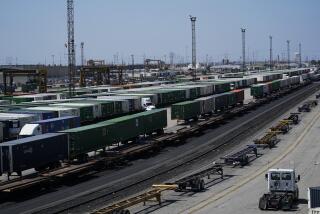Poor Maintenance Cited in Train and Plane Crashes
- Share via
WASHINGTON — Federal safety investigators Tuesday blamed poor track maintenance for last year’s fatal crash of the Amtrak Auto Train in Florida.
Poor maintenance also contributed to the February 2000 fatal crash of an Emery Worldwide Airlines cargo plane in California, the National Transportation Safety Board said.
The five-member board unanimously approved both findings Tuesday and issued a series of recommendations to address the shortcomings.
In the Auto Train crash, the board found the track’s owner, CSX Transportation, did not ensure the rails were properly aligned and had adequate support.
The finding carries no penalty, but it can aid victims seeking compensation for an accident.
“This is something that should have been prevented through proper maintenance,” NTSB Chairwoman Ellen Engleman said.
The Auto Train, one of Amtrak’s most popular services, travels between the Washington, D.C., suburb of Lorton, Va., and Sanford, Fla., near Orlando. It was headed north when it derailed near Crescent City, Fla., shortly after 5 p.m. on April 18, 2002. Four people were killed and 36 seriously injured.
After the wreck, the train’s engineer told investigators he had seen a misalignment of the track just ahead and was trying to apply the brakes when the force of the derailment threw him against the wall.
CSX employees and Florida rail safety inspectors told the NTSB that the section of track was troublesome because it was built on a steep embankment, and the gravel used for support kept sliding away.
A CSX coal train passed over the track just before the Auto Train and that crew told safety investigators they noticed no roughness or irregularity.
CSX spokesman Gary Sease said the company already has complied with the NTSB’s recommendation to develop a program to ensure its employees follow the company’s maintenance standards.
In the Emery crash, federal safety investigators said a missing bolt caused part of an elevator assembly to separate. The safety board said maintenance workers failed to properly attach and inspect the bolt.
The DC-8 crashed shortly after takeoff from an airport near Sacramento, killing all three crew members.
Board investigators said after the bolt came loose, the elevator assembly separated and the pilots could not keep the plane in the air. The elevator raises and lowers the plane’s nose.
Investigators said the crash would not have occurred had the plane been properly maintained and inspected. Emery had hired a repair firm approved by the Federal Aviation Administration to do the maintenance.
“It was a tragedy. It should not have occurred,” Engleman said.
The NTSB recommended new inspections of DC-8 elevator assemblies, and new procedures requiring pilots to make sure the elevators are working before they take off.
Since the crash, Boeing has changed the DC-8 maintenance manual to include checks of the control rod that connects the tab to the elevator, and added a new section to its pilot training guide that deals with controlling the plane when the nose is stuck in the up position, spokeswoman Liz Verdier said.
In addition, the company plans to provide a kit by mid-2004 to retrofit the remaining 148 DC-8s still in service, she said.
In August 2001, Emery grounded its air fleet after the FAA found more than 100 possible safety violations.
The FAA said Emery made improper and inadequate repairs to mechanical irregularities that had been flagged by the airline’s pilots; made unapproved alterations to its aircraft; failed to keep adequate records; and did not follow the policies in its manuals.
Emery no longer flies. The company ships cargo aboard other airlines.
More to Read
Sign up for Essential California
The most important California stories and recommendations in your inbox every morning.
You may occasionally receive promotional content from the Los Angeles Times.










